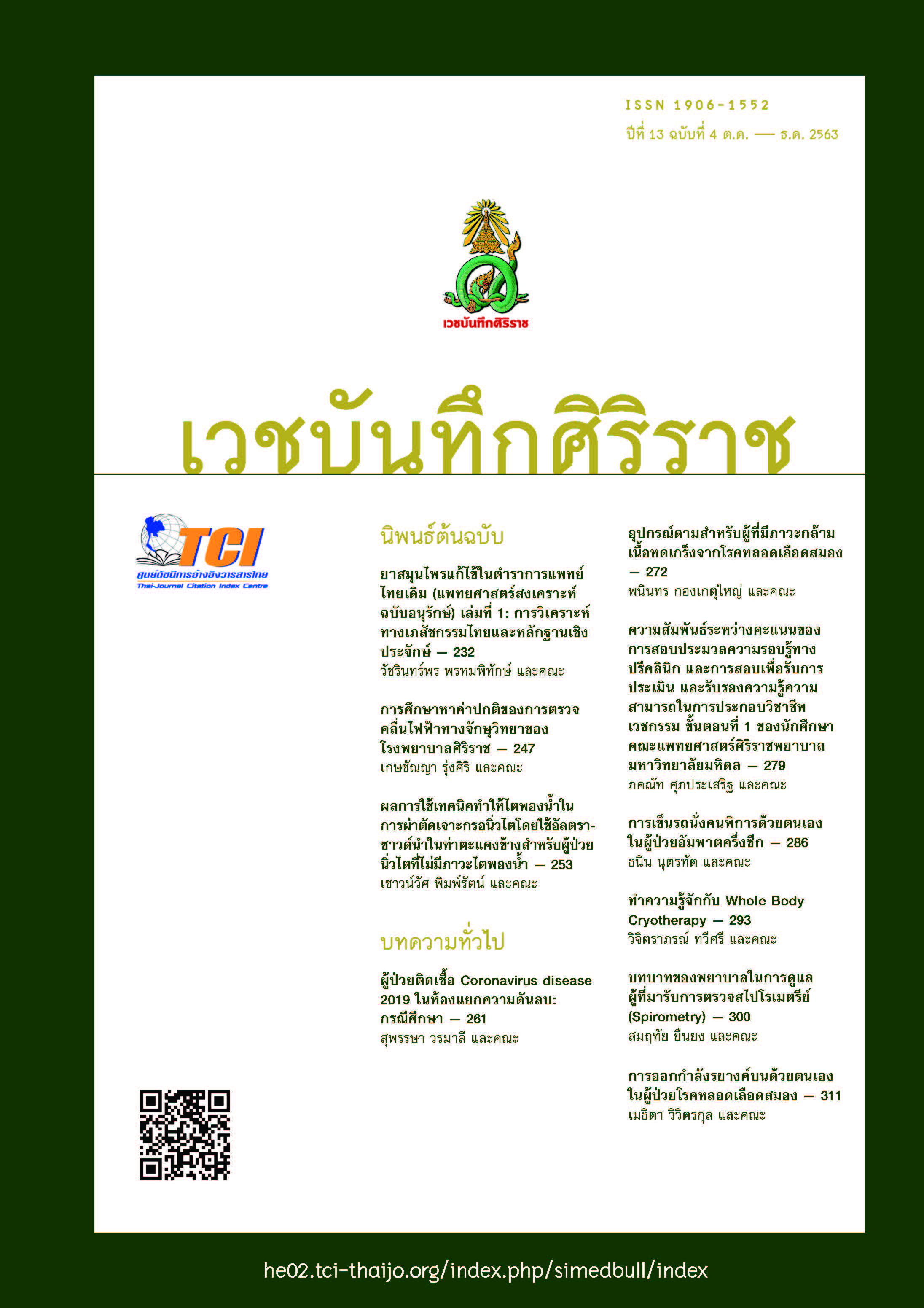Splint for Spasticity after Stroke
Main Article Content
Abstract
Splint is an orthosis, which is made from special materials that can be softened by hot water and reversely be hardened by cooling. These features made splint been capable of adjusting to the shapes as required. Splint is used for supporting many parts of the body in the purposes of immobilization or posture correction. The patients with spasticity after stroke will have hypertonia and flexor synergy of their upper extremities which cause joint stiffness and muscle contracture, especially wrist and hand muscles. Therefore, splint has an important role for reducing spasticity in various forms of use. Stretching exercise should be performed before wearing the splint and use it with the proper wearing time, thereby increasing the efficiency of splint in spasticity.
Article Details
References
2. Lance JW. Symposium synopsis. In : Feldman RG, Young RR, Koella WP, eds. Spasticity : Disordered motor control. Chicago: Year Books Medical Publishers; 1988: 485–94.
3. Mayer NH. Clinicophysiologic concepts of spasticity and motor dysfunction in adult with an upper motor neuron lesion. In: Simpson DM, Mayer NH. Eds. Spasticity: etiology, evaluation, management and the role of botulinum toxin. WE MOVE 2002: 1–10.
4. Basaran A, Emre U, Karadavut KI et al. Hand Splinting for Poststroke Spastic : A Randomized Control Trial. Stroke Rehabil 2012; 19(4): 329–37.
5. วิสุทธินี เทือกทอง, วิษณุ กัมทรทิพย์ และคณะ. ผลการลดเกร็งของแขนและมือในผู้ป่วยโรคหลอดเลือดสมองที่เกิดขึ้นทันทีหลังจากการเหยียดยืดเอ็นและกล้ามเนื้อแบบนิวโรฟิสิโอโลจิก เปรียบเทียบกับการเหยียดยืดแบบออร์โธปิดิกส์ : รายงานการวิจัยเบื้องต้น. เวชศาสตร์ฟื้นฟูสาร 2558; 25(1): 22-9.
6. Mc Pherson LM, Dewald J. Differences between flexion and extension synergy–driven coupling at the elbow, wrist and finger of individuals with chronic hemiparetic stroke. Clinical Neuro Phusiology. 2019; 130: 454–68.
7. Watkins CL, Leathley MJ et al. Prevalence of spasticity poststroke. Clin Rehabil 2002 ; 16: 515–22.
8. อารีรัตน์ สุพุทธิธาดา. ภาวะกล้ามเนื้อหดเกร็ง(Spasticity). กรุงเทพมหานคร: คณะแพทยศาสตร์ จุฬาลงกรณ์มหาวิทยาลัย; 2547.
9. Hsu JD, Michael JW, Fisk JR. Upper limb orthoses for the stroke and brain-injured patient. In: Mariani C, Keenan MA. AAOS Atlas of Orthoses and assistive devices. 4thed. Mosby. P191-201.
10. Cifu DX, Kaelin DL, Kowalske KJ, Lew HL, Miller MA, Ragnarsson KT et al. Braddom’s physical medicine & rehabilitation. 5thed. Canada: Elsevier; 2016.
11. กิ่งแก้ว ปาจรีย์. การฟื้นฟูระบบประสาททันยุค 2561. กรุงเทพมหานคร: ภาควิชาเวชศาสตร์ฟื้นฟู คณะแพทยศาสตร์ศิริราชพยาบาล มหาวิทยาลัยมหิดล, 2561.
12. วิไลวรรณ มณีจักร. การทำอุปกรณ์ดามปลายแขนและมือด้วยเทอร์โมพลาสติก. เอกสารประกอบการสอน รายวิชาอุปกรณ์ดามและอุปกรณ์เสริม 513328. 2558: ภาวิชากิจกรรมบำบัด คณะเทคนิคการแพทย์ มหาวิทยาลัยเชียงใหม่.
13. Adrienne C, Manigandan C. Inpatient occupational therapist hand – splint practice for clients with stroke: A cross – sectional survey from Ireland. J Nerurosci Rural Pract. 2011; 2(2): 141–49.
14. Naomi O'Reilly, Vidya Acharya, Kim Jackson, Scott Buxton and Evan Thomas. Neurology Treatment Techniques [Internet]. [cited 2020 April 7]. Available from: https://www.physio-pedia.com/Neurology_Treatment_Techniques
15. Reeves S, Lambeth K. The role of Physical and Occupational Therapy in the Evaluation and Management of Spasticity [Internet]. 2017 [cited 2020 Mar 16]. Available from: https://musculoskeletalkey.com/the-role-of-physical-and-occupational-therapy-in-the-evaluation-and-management-of-spasticity/
16. Sung Ho Janf, Woo Hyuk Jang. Difference in cortical activation during use of volar and dorsal hand splints : a functional magnetic resonance imaging study. Neural Regen Res.2016 Aug; 11(8): 1274–77.
17. Jong – Bae Choi, Jong – Eun Yang et al. The Effect of Different Types of Resting Hand Splint on Spasticity and Hand function among Patients with Stoke. J Ecophysiol Occup Hlth. 2016; 16(1&2): 42–51.
18. Slowman LS. The Athlete. In: Jacobs MA. Splinting the hand and Upper extremity. 2003: 425–32.


